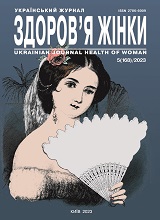Risk factors for the ineffectiveness of assisted reproductive technology programs after a woman’s illness with COVID-19
Keywords:
woman, COVID-19, long-COVID, infertility, assisted reproductive technologies, risk factorsAbstract
Purpose - to determine the risk factors for the ineffectiveness of ART programs after a woman’s illness with COVID-19.
Materials and methods. In the group of 80 examined patients with symptoms of “long-COVID” who applied to the reproductive technology clinic for infertility treatment, 2 subgroups were distinguished: the Subgroup 1: 64 patients in whom assisted reproductive technologies (ART) was unsuccessful (cancellation of transfer, non-occurrence of pregnancy or its loss) and the Subgroup 2: 16 women with successful ART (live birth).
Results. Significant differences were found among patients with unsuccessful use of ART in terms of the frequency of the main symptoms of “long-COVID”, the following symptoms stand out: “depression, anxiety” (54.7% vs. 18.8%, p<0.05) and “sleep disturbances” (59.4% vs. 31.3%, p<0.05).
A significant difference was also found in social and household factors: the presence of stress (35.9% vs. 12.5%, p<0.05), especially in everyday life (31.3% vs. 6.3%, p<0.05), the presence of bad habits (21.9% vs. 6.3%, p<0.05).
A significantly higher frequency of decreased ovarian reserve (32.8% vs. 12.5%, p<0.05) and corresponding hormonal disorders: increased follicle-stimulating hormone (21.9% vs. 6.3%, p<0.05) and decreased anti-Müllerian hormone (25.0% vs. 6.3%, p<0.05).
Among somatic pathology, endocrine pathology stands out (45.3% vs. 12.5%, p<0.05), in particular metabolic disorders (34.4% vs. 12.5%, p<0.05). A significant difference was also established in the frequency of liver diseases (21.9% vs. 6.3%, p<0.05) and gastrointestinal tract (23.4% vs. 12.5%, p<0.05).
There is a higher frequency of menstrual disorders, namely a decrease in the duration of menstruation (20.3% vs. 6.3%) or, conversely, prolonged menstruation (17.2% vs. 6.3%), an irregular cycle (25.0% vs. 6.3%, p<0.05) and luteal phase insufficiency (21.9% vs. 6.3%, p<0.05). Urogenital infections were noted in 43.8% of patients (vs. 12.5%, p<0.05).
Conclusions. Risk factors for the ineffectiveness of ART programs have been established, among which stress, depression and anxiety, bad habits, endocrine pathology, metabolic disorders, liver pathology, menstrual cycle disorders, and urogenital infections are especially highlighted.
The research was carried out in accordance with the principles of the Declaration of Helsinki. The research protocol was approved by the Local Ethics Committee of the institution mentioned in the work. Informed consent of the women was obtained for the research.
No conflict of interests was declared by the authors.
References
D'Ippolito S, Turchiano F, Vitagliano A, Scutiero G, Lanzone A, Scambia G, Greco P. (2022, Mar 2). Is There a Role for SARS-CoV-2/COVID-19 on the Female Reproductive System? Front Physiol. 13: 845156. https://doi.org/10.3389/fphys.2022.845156; PMid:35309055 PMCid:PMC8924447
Golovchak IS. (2023). The reproductive function of women with infertility after suffering COVID-19 infection. Ukrainian Journal Health of Woman. 3 (166): 4-9. https://doi.org/10.15574/HW.2023.166.4
Greenhalgh T, Knight M, A'Court C, Buxton M, Husain L. (2020, Aug 11). Management of post-acute covid-19 in primary care. BMJ. 370: m3026. https://doi.org/10.1136/bmj.m3026; PMid:32784198
Halpin SJ, McIvor C, Whyatt G, Adams A, Harvey O, McLean L et al. (2021, Feb). Postdischarge symptoms and rehabilitation needs in survivors of COVID-19 infection: A cross-sectional evaluation. J Med Virol. 93(2): 1013-1022. https://doi.org/10.1002/jmv.26368; PMid:32729939
Nateghi R, Ghashghaei SH, Shokoohian B, Hezavehei M, Ebrahimi B, Shahverdi AH et al. (2021). Female Reproductive Health in SARS-CoV-2 Pandemic Era. International journal of fertility & sterility. 15(4): 241-245. https://doi.org/10.22074/IJFS.2021.534956.1164.
Özdemir Ö, Arslan Z. (2022, Jul 20). Issues related to post-COVID-19 syndrome. World J Methodol. 12(4): 224-234. https://doi.org/10.5662/wjm.v12.i4.224; PMid:36159103 PMCid:PMC9350724
Prasad S, Tiwari M, Pandey AN, Shrivastav TG, Chaube SK. (2016, Mar 29). Impact of stress on oocyte quality and reproductive outcome. J Biomed Sci. 23: 36. https://doi.org/10.1186/s12929-016-0253-4; PMid:27026099 PMCid:PMC4812655
Rooney KL, Domar AD. (2018, Mar). The relationship between stress and infertility. Dialogues Clin Neurosci. 20(1): 41-47. https://doi.org/10.31887/DCNS.2018.20.1/klrooney; PMid:29946210 PMCid:PMC6016043
Salari N, Hosseinian-Far A, Jalali R, Vaisi-Raygani A, Rasoulpoor S, Mohammadi M et al. (2020. Jul 6). Prevalence of stress, anxiety, depression among the general population during the COVID-19 pandemic: a systematic review and meta-analysis. Global Health. 16(1): 57. https://doi.org/10.1186/s12992-020-00589-w; PMid:32631403 PMCid:PMC7338126
Shah W, Hillman T, Playford ED, Hishmeh L. (2021, Jan 22). Managing the long term effects of covid-19: summary of NICE, SIGN, and RCGP rapid guideline. BMJ. 372: n136. Erratum in: BMJ. 2022 Jan 19; 376: o126. https://doi.org/10.1136/bmj.n136; PMid:33483331
Tesarik J, Mendoza-Tesarik R. (2022, Jul 18). Patient-tailored reproductive health care. Front Reprod Health. 4: 917159. https://doi.org/10.3389/frph.2022.917159; PMid:36303620 PMCid:PMC9580787
Zhylka N, Slabkiy G, Shcherbinska O. (2021). The state of female reproductive health in Ukraine: Literature review. Reproductive Endocrinology. 60: 67-71. https://doi.org/10.18370/2309-4117.2021.60.67-71
Downloads
Published
Issue
Section
License
Copyright (c) 2023 Ukrainian Journal Health of Woman

This work is licensed under a Creative Commons Attribution-NonCommercial 4.0 International License.
The policy of the Journal UKRAINIAN JOURNAL «HEALTH OF WOMAN» is compatible with the vast majority of funders' of open access and self-archiving policies. The journal provides immediate open access route being convinced that everyone – not only scientists - can benefit from research results, and publishes articles exclusively under open access distribution, with a Creative Commons Attribution-Noncommercial 4.0 international license (СС BY-NC).
Authors transfer the copyright to the Journal UKRAINIAN JOURNAL «HEALTH OF WOMAN» when the manuscript is accepted for publication. Authors declare that this manuscript has not been published nor is under simultaneous consideration for publication elsewhere. After publication, the articles become freely available on-line to the public.
Readers have the right to use, distribute, and reproduce articles in any medium, provided the articles and the journal are properly cited.
The use of published materials for commercial purposes is strongly prohibited.

